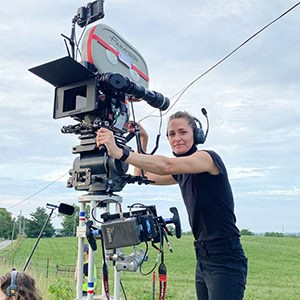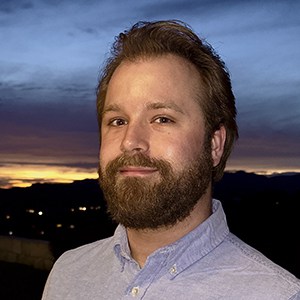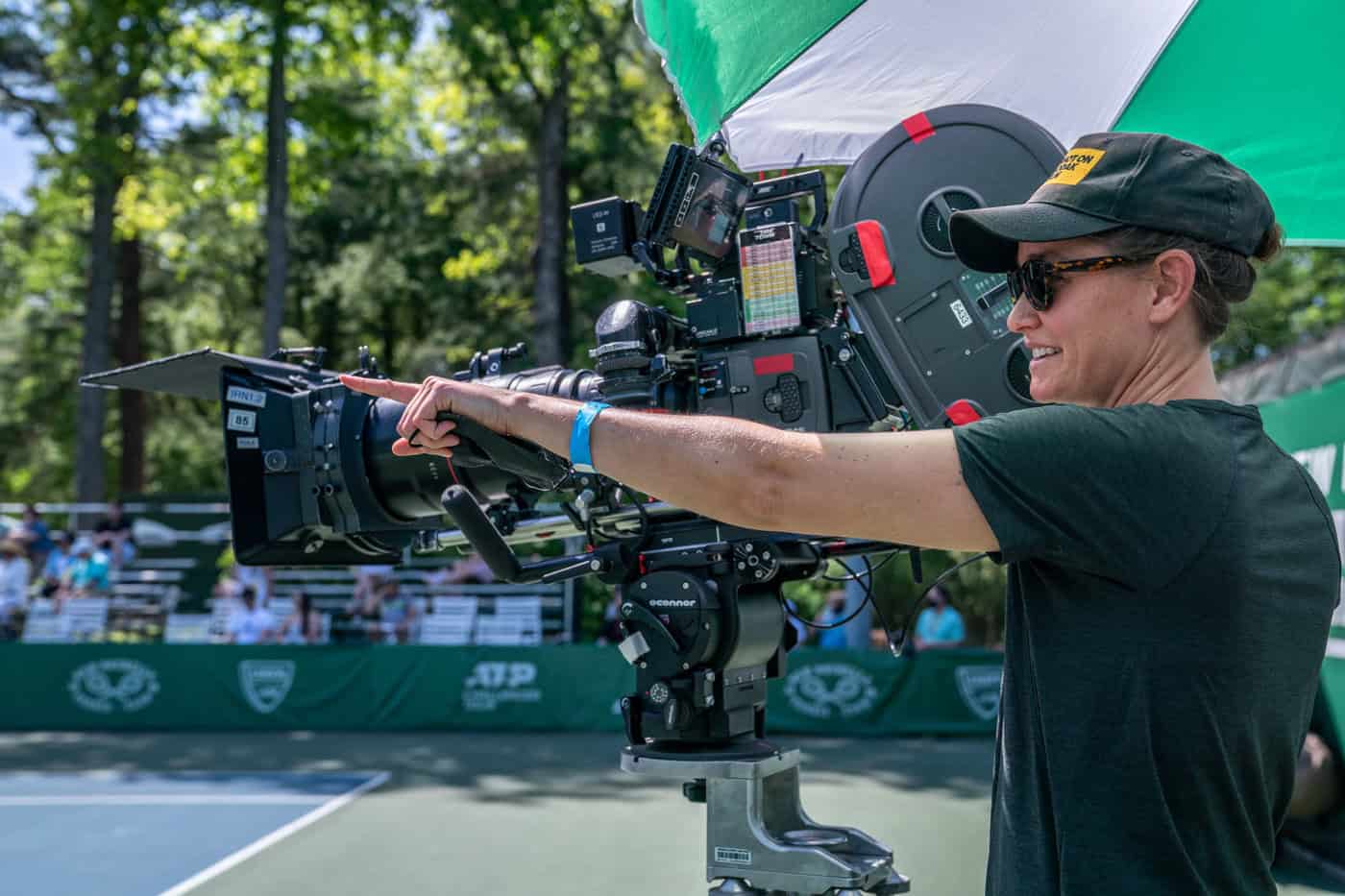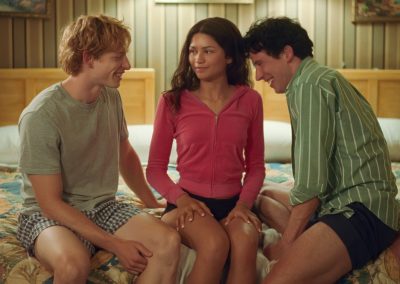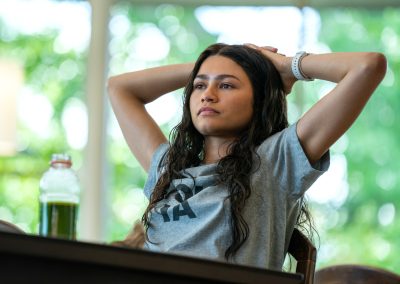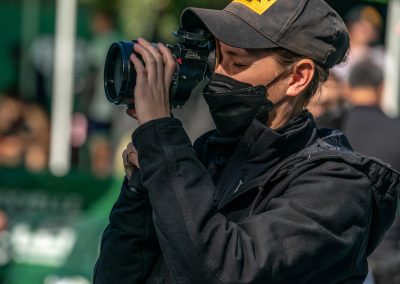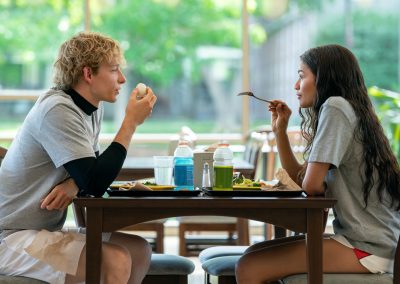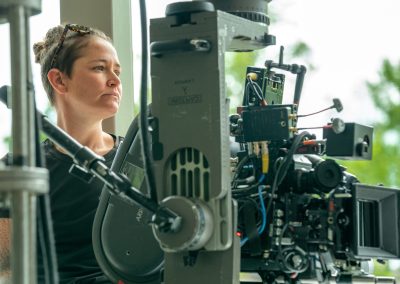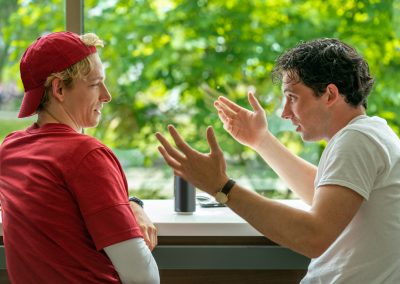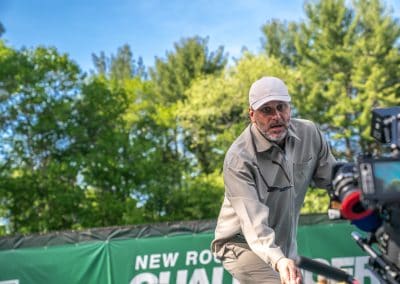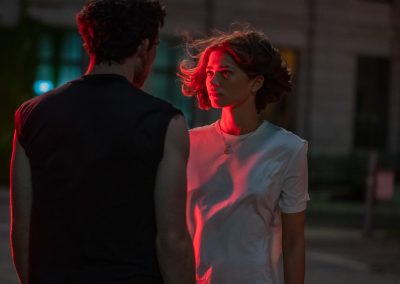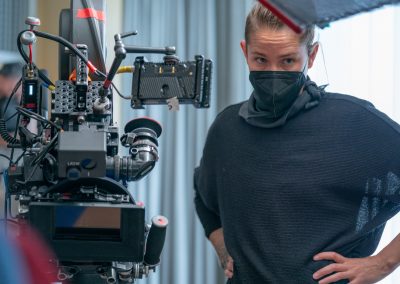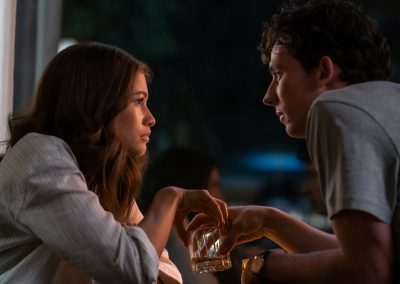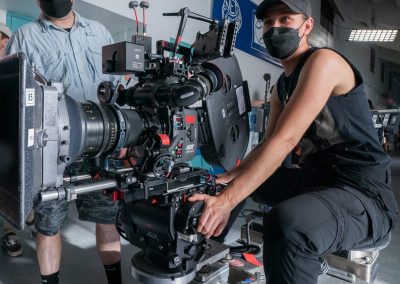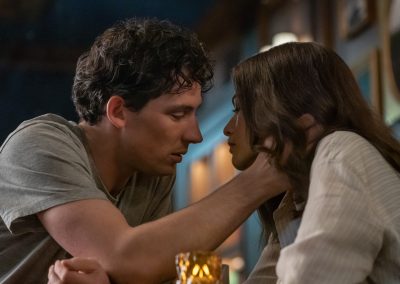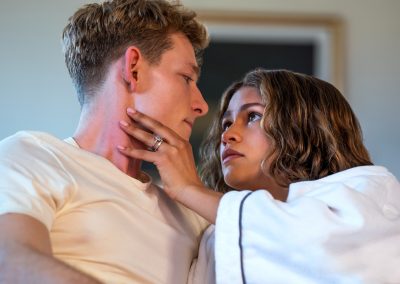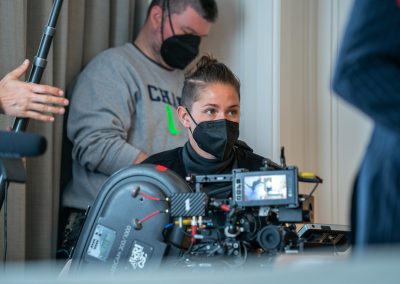CHALLENGERS
Tension and Release
A Conversation with Bianca Butti
By David Daut
In the current cinematic climate, an adult-oriented sports drama centered around tennis as an elaborate metaphor for sexual frustration doesn’t necessarily seem like a surefire hit, and yet Challengers has proven to be a commercial success as well as a critical one, opening at number one in the US box office when it was released this past April.
Camera Operator had the chance to speak with A camera operator Bianca Butti about working on the film—from the way camera movement underscores the film’s sense of rising tension, to capturing every beat of the carefully choreographed tennis matches.
During the US Open, friends Patrick Zweig and Art Donaldson meet tennis prodigy Tashi Duncan and immediately begin competing for her affection. The pair quickly twists into rivalry both on the court and off before ultimately ending their friendship. Thirteen years later, Tashi and Art are married; Art is now a fading star ready to quit the game, while Tashi lives her unrealized dreams through Art after an injury put an early end to her career. In the midst of this, Art enters a Challenger event as a wild card where he ends up—once again—competing against Patrick. Challengers is directed by Luca Guadagnino from a screenplay by Justin Kuritzkes. It stars Zendaya, Josh O’Connor, and Mike Faist.
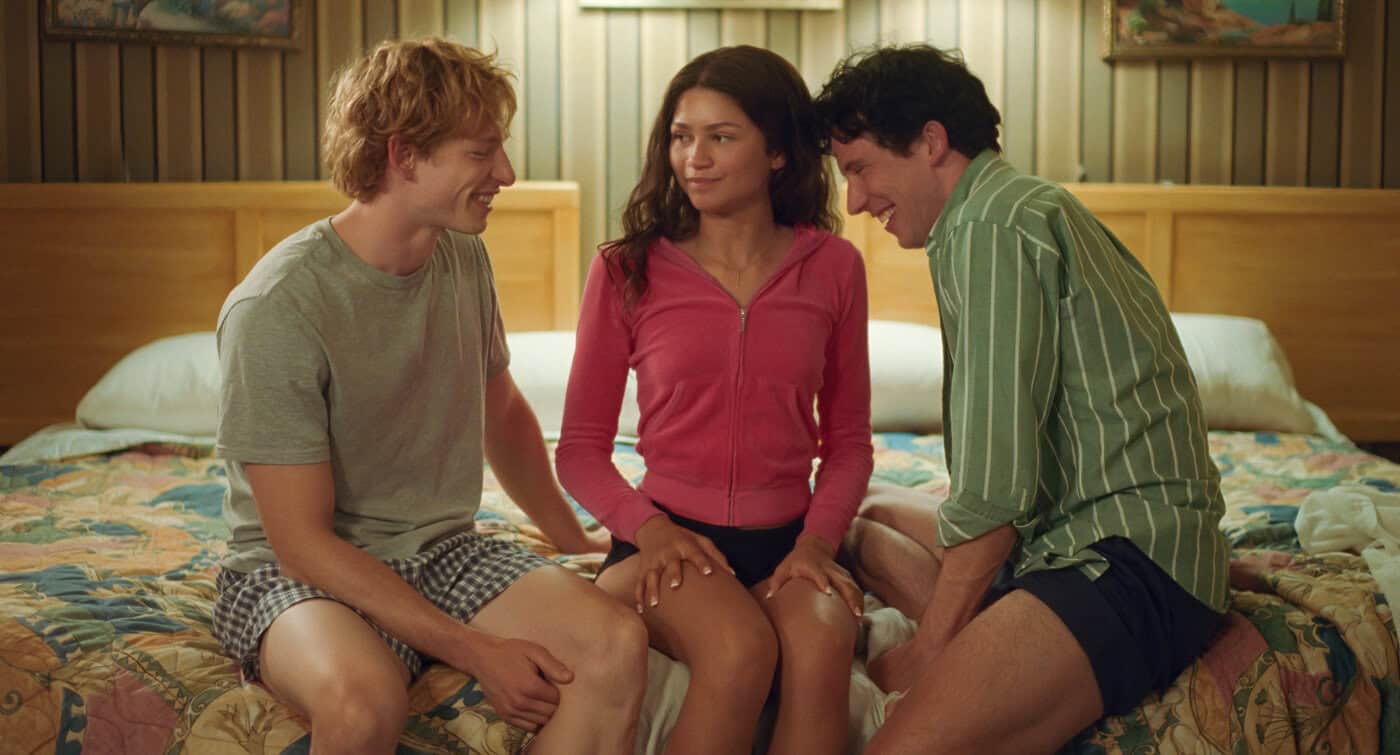
Camera Operator: To start things off, tell me a little bit about how you got the job as A camera operator on Challengers.
Bianca Butti: Luca [Guadagnino] and I worked on Bones and All together, which was shot by Arseni Khachaturan, who I had not met before. I got hired on the job as the operator because I applied through my friend Merissa Lombardo. She was a set decorator for Luca at the time—she then became the production designer of Challengers. That project went really well; Luca liked how I operated, and he liked working with me, so I got the call to work on Challengers. I was actually pretty surprised that he called me to work on this huge, $60 million MGM movie.
CO: So you’d worked with Luca Guadagnino on Bones and All, but if I’m not mistaken, this was your first time working with cinematographer Sayombhu Mukdeeprom. Could you talk a little bit about what the working relationship was like between the three of you?
Butti: Yeah, Sayombhu is one of the nicest people I’ve ever met. Before we started shooting, Luca came up to me and said, “You are going to love Sayombhu. He is like heaven.” And that was true! He’s so easy to be around, and he’s so brilliant in the way that he lights things. He’s very efficient and quiet, and he had full trust in me through Luca’s recommendation. When we all got onto Challengers for pre-production, Sayombhu let me just be in charge of all things camera while he was in charge of lighting, with Luca steering the ship. Luca has a lot of very specific ideas; he had mapped out the entire movie, how he wanted to shoot all the tennis sequences, what he wanted to do, and then it was up to Sayombhu and the great team that we assembled in Boston to achieve that goal. The tennis sequences took way longer than we thought they were going to take. Every point of every match was mapped out as a story beat, and each one was necessary for how they were going to cut. Everything was very specific. We thought it was going to be a week-and-a-half at the tennis courts, but it turned out to be three weeks.
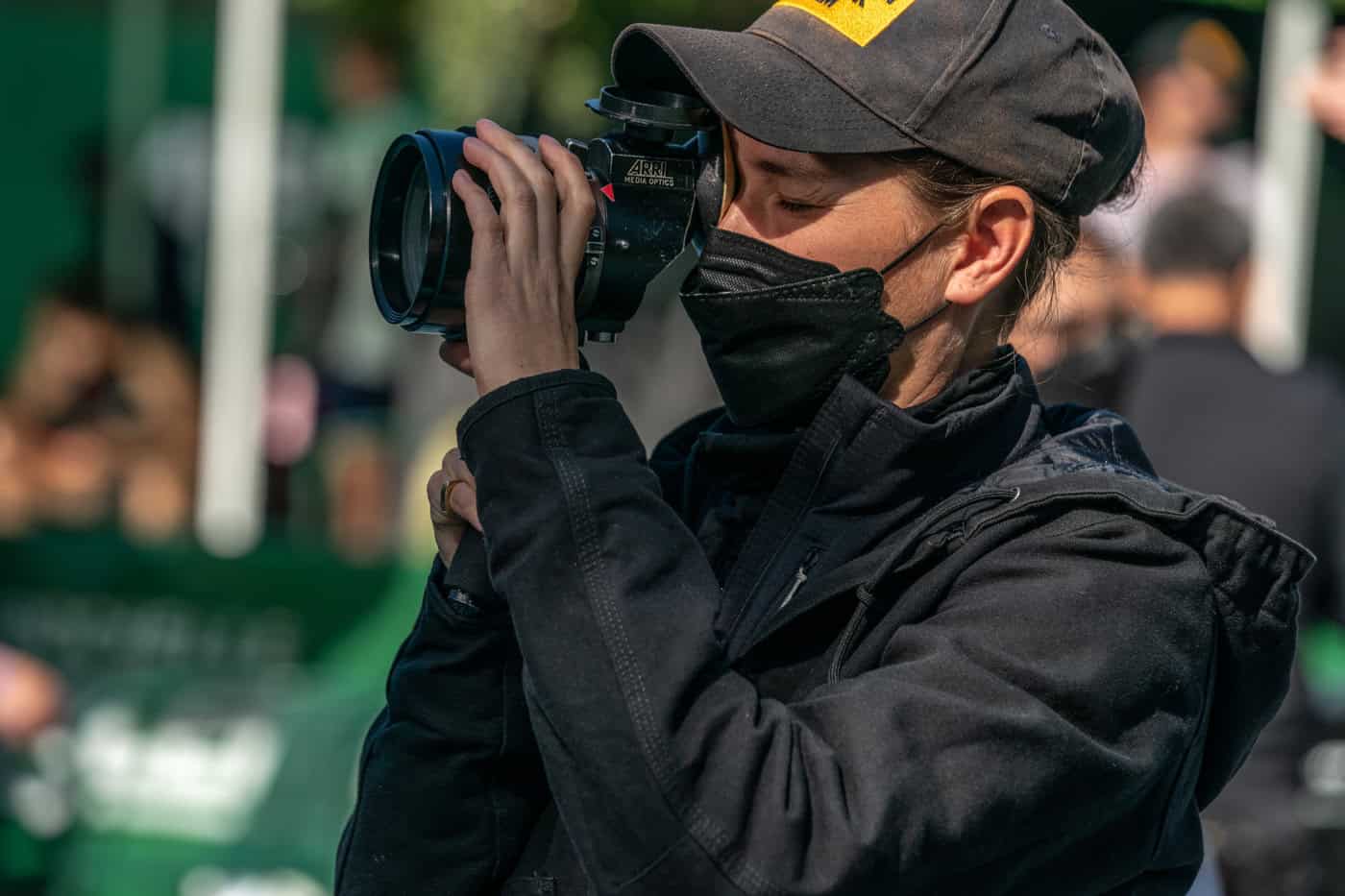
CO: Tell me a little bit more about the logistical complexities of shooting those tennis sequences. Obviously, it’s very different from shooting an actual tennis match, where the cameras would be off to the side. In this, you’re right there in the thick of it. How did you navigate those sequences as a camera operator?
Butti: You know, you shoot it as you shoot things. We’d shoot with the actors, and then we’d shoot with the body doubles, and then we’d shoot with the actors again without tennis balls, and then we’d shoot with the body doubles without tennis balls. It was a lot of shooting and reshooting, and shooting the same shot again and again, while you’re right there on the court. There are some digital effects where it looks like the ball is going right at the lens; that wasn’t really happening. The tennis pros that we worked with had mapped out the entire game, point for point, exactly where things land on the court, so nothing was a real surprise since all the points were already drawn up perfectly. We knew where everything was going, so it wasn’t like filming a real tennis game. It was really about all the tension that goes into every single point that is made in a tennis match, which I think [screenwriter Justin Kuritzkes] did a really good job of making a very specific point. It was all written into the script.
CO: And I feel like there’s sort of a progression to the camera work in this movie. Early on, it’s a little more rigid—kind of locked off shots, very smooth tracking shots, slow push-ins—but then, as you get deeper into the film, especially towards the end where the interpersonal and sexual tension between these three people is kind of at its zenith, we start seeing more handheld work and even some more unconventional, hyperkinetic POV shots. There’s the POV of the players on the court, and even one where the camera is bouncing back and forth like it’s the tennis ball. How do you think the camera work contributed to that feeling of building tension throughout the film, and what went into getting some of those crazier shots?
Butti: Yeah, I think the camera work really elevates the tension of the movie. And Luca was willing to take the time to make all of those shots happen. We shot tennis every which way and also worked closely with the effects guys at Zero VFX, spending days mapping this stuff out. We would mount the camera onto a crane, and we would send the crane through the court, back and forth several times in every direction, spinning it this way and that. Then, they would take that footage—which we shot all on film—digitize it, and add the digital elements on top of it. Luca was really excited about the camera becoming the POV of the ball. He just had this idea from the beginning. You know, he’s a very excitable person. He’s very excited about these shots, and everybody’s going, “How are we going to make this happen?” But, they made it happen, and it looked beautiful. It’s fun, and it fits right into the perfect part of the movie. It really sucks you completely into the game. It’s just totally brilliant.
There are also some shots from underneath the court. Luca wanted to shoot underneath a clear floor, which they actually ended up shooting in Italy, because in America, it was too hard logistically to put that together. But yeah, it was just shooting in a lot of different ways. I mean, each shot was its own unique journey, nothing was repeated. Every toss of the ball, everything had its own moment. We worked a lot with a couple of different cranes, also pushing the dolly on the court, camera in low mode following the ball. It was a lot of different things. Every day was an exciting thing to shoot, because it was going to be something totally different.
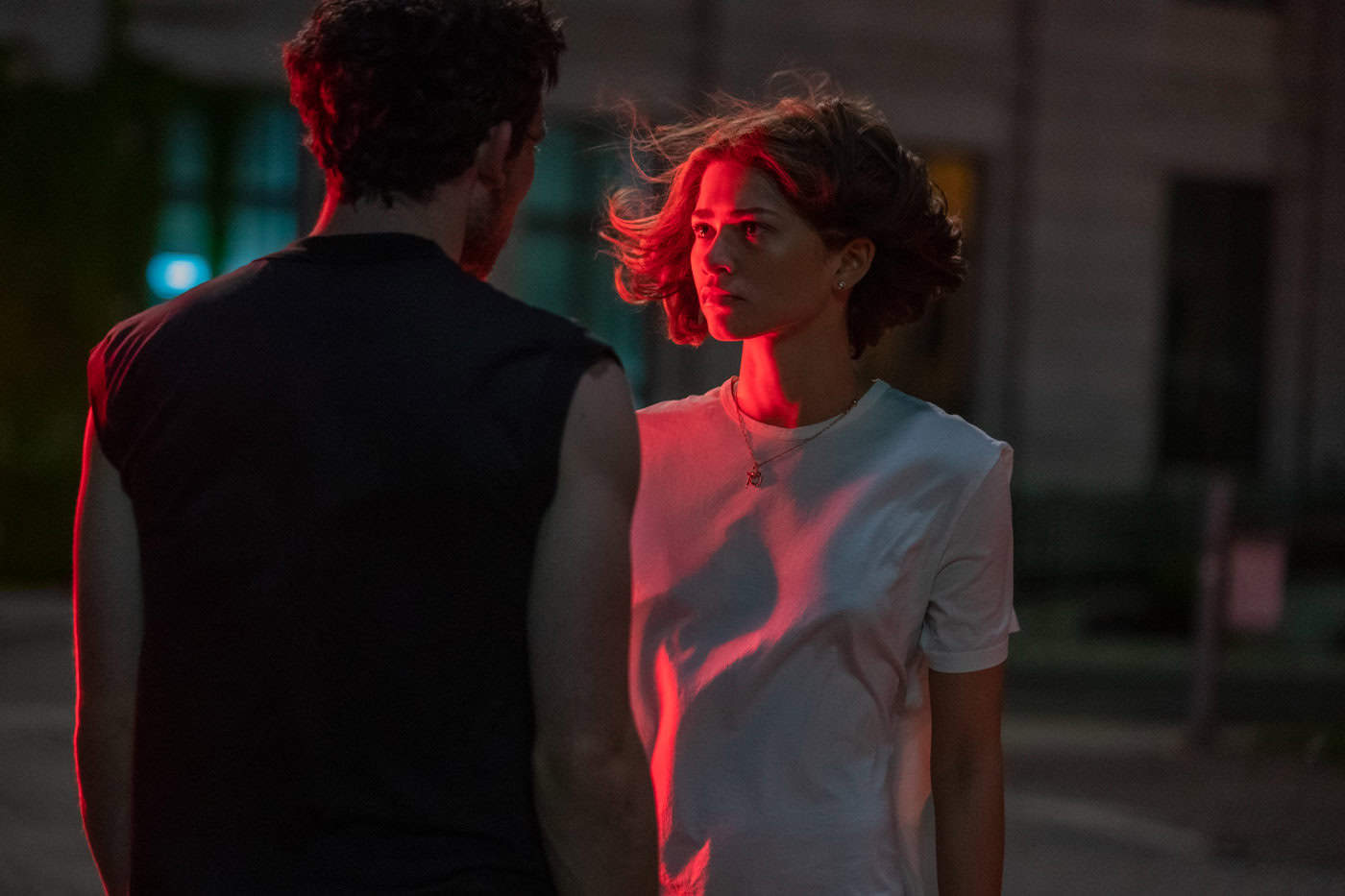
CO: You touched on this a little bit, but what equipment did you use to get some of these shots? You talked about sending the camera back and forth on the crane for the tennis ball shots and shooting up through plexiglass. What other kinds of tools and tricks did you use on this movie?
Butti: That was most of what we did. It was cranes, and there’s a lot of dolly stuff on the actual court. Luca doesn’t like a lot of stuff. He likes it to be very organic, very straightforward. He got really into the crane because it can do all these different things, but generally he likes it very simple. He likes to construct shots to make them more dynamic in movement, but not with a lot of extra equipment. We rented all sorts of equipment and he just said, “I can’t use any of this stuff. I like the dolly and I like the crane, and that’s how we’re going to achieve everything.” So, everything was molded around making those tools work.
CO: To that point, right at the start of the movie, there is this really cool push-in all the way across the tennis court as we’re getting introduced to these characters. It starts on the far end of the tennis court, then zooms all the way in to a close up on Zendaya’s character on the opposite side. I assume that was another crane shot?
Butti: Yeah, that’s a Super Technocrane with, I believe, an 18 millimeter lens. It starts as far back as it could, wide up the court, and cranes down. It’s a blended shot, so the crane comes down and goes all the way close to her face, and then we did it again where we’re on the other side of the umpire, still using the crane, but floating on a tighter lens, and then again on an even tighter lens. The VFX people clip all those together so it becomes one continuous shot right into a close up of her face.
CO: It’s a great way to establish the visual language of the film right at the start.
Butti: Yeah, and you also have those hyper-slow-motion shots of just the three faces. Those were hard to achieve because it’s hard to find a camera in America that can shoot film at a high enough frame rate. They don’t exist anymore. Only NASA owns these high-frame-rate film cameras. We had to fly a guy in from Italy, Max Lucito, who has a Photo-Sonics 4B camera that shoots 1000 frames per second. It is the loudest thing you’ve ever heard in your life; it sounds like a lawnmower on steroids. It goes by in 10 seconds, the film flies through it, then it explodes in the magazine, and you have to take it out and clean the whole camera. That was fun to shoot with that camera. It looks like the film emoji on your phone. It’s this old school, Mickey Mouse–looking camera. Just a tank, but a beautiful camera, and I think those shots are so special and incredibly beautiful.
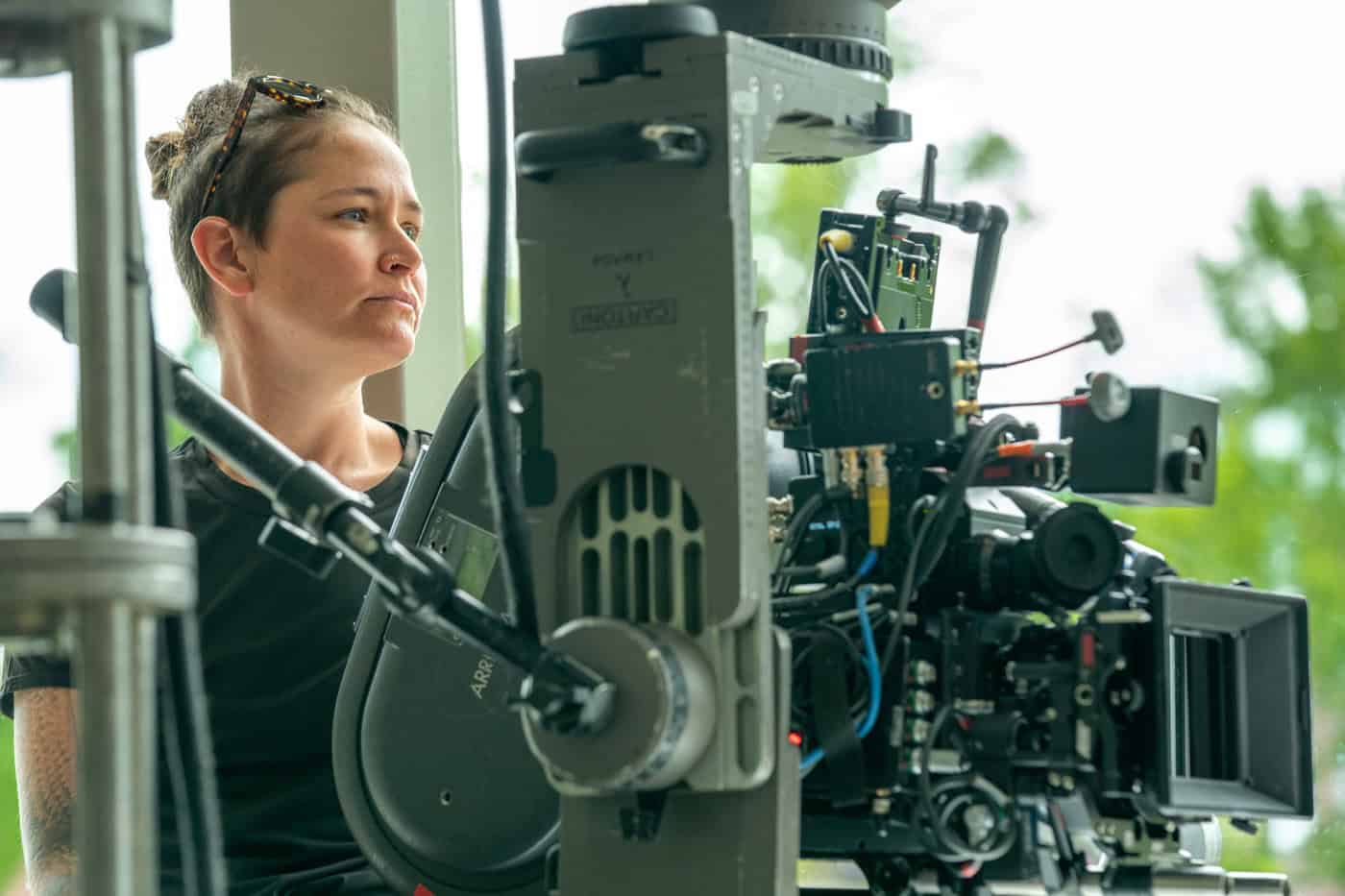
CO: Switching gears a little bit, the cast in this film is great. Zendaya, obviously, is a massive star. You’ve got Mike Faist, who was incredible in Steven Spielberg’s West Side Story. Josh O’Connor is terrific as well. What was it like working with the cast on this movie?
Butti: They were fantastic, all of them. Everybody was fantastic on the movie. Zendaya is just a wonderful person, and she’s so interested in film and filmmaking. She was often on set when she didn’t need to be just asking questions and hanging out and walking around in her hooded sweatshirt with her dog. It really became like a family. Mike’s a super sweet guy, and Josh is as well. Everybody was just lovely and having a good time, and just making tennis happen.
CO: Any fun or memorable stories with them from the set?
Butti: You know, this was two years ago. It’s hard to remember. They were just so great to be around. Zendaya is a very professional person. She could go from having a conversation with you and then snap right into her role, do her thing, and then pop right back over and keep talking. Just a real easy person to deal with. I’ve definitely dealt with some not easy people in the past, but this cast was all so lovely.
CO: We’ve talked about some specific shots on the film, and working with the cast. What were some of the other memorable moments from shooting the film? Any other particular shots or sequences beyond what we’ve already discussed that stand out?
Butti: Early on in the film, we’re shooting at the Four Seasons in Boston, and the A camera dolly grip is a guy named Chappy—Chris Chapman—who’s out of Atlanta, great dolly grip. We’re standing in this hotel room, we had shot all night, and the sun was coming up, and we had to black out all the windows. We’re doing this shot in the scene where Zendaya’s character and Mike Faist’s character are on the bed, and they’re having this moment, and they’re maybe gonna have sex, but then he just wants her to hold him. Luca’s describing what he wants, and he’s saying, “We go up to her face, and then down to his face, and then over here, and then the dolly comes this way, and then we go back around this way, we pull out, and then we go to the window.” Chappy and I look at each other, uncertain. Luca says, “It’s really very simple,” and then he walks away. The shot in the movie doesn’t look that complicated, because it’s subtle, and the way that it pans around to both of them and tilts, and it all sort of becomes this one delicate sequence, but there was really a lot of footwork and dolly pushing and zooming and panning, so it was kind of a complicated shot, which Luca loves to do.
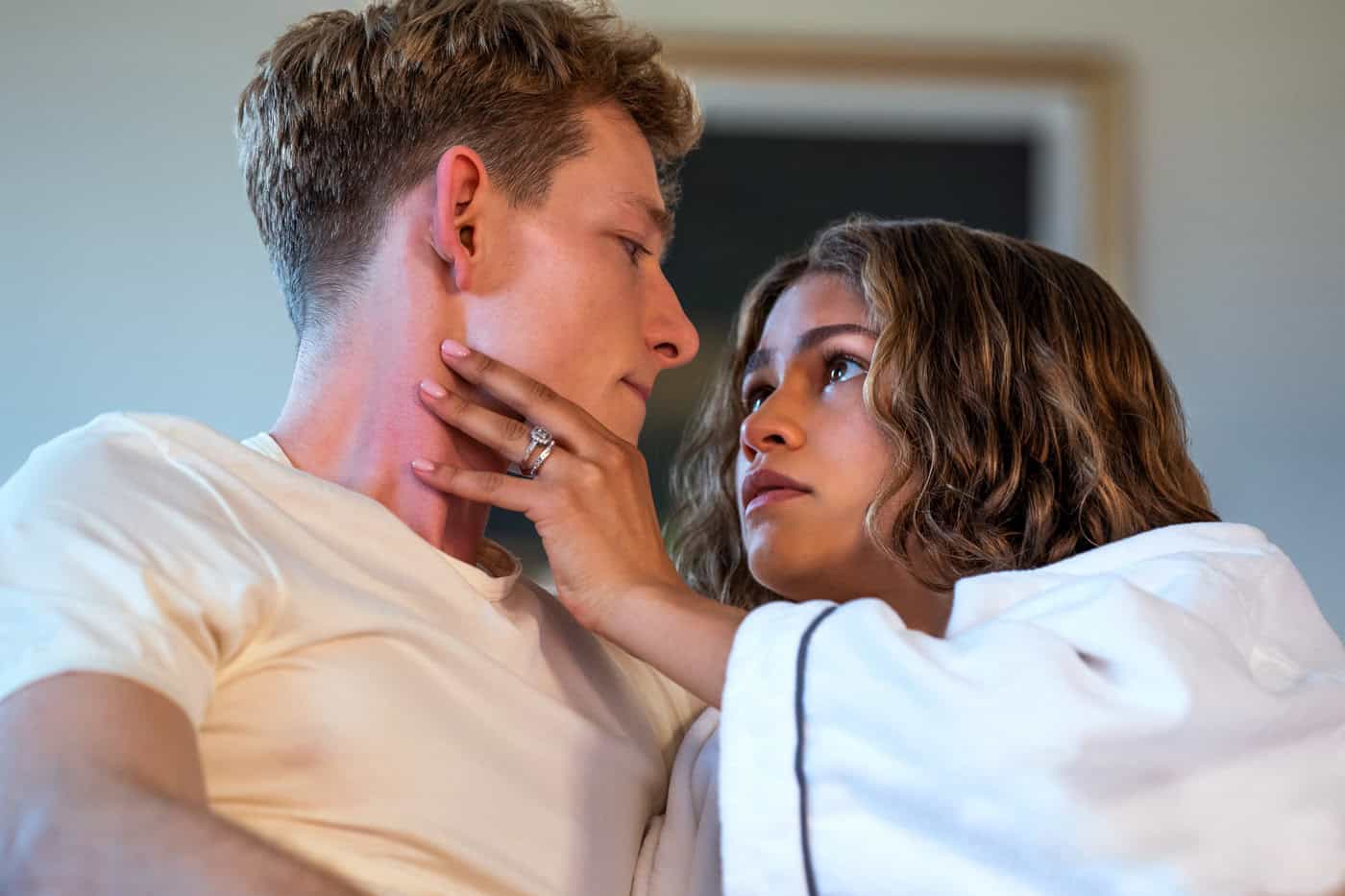
The other shot that comes to mind is a oner in the movie. It’s six and a half minutes, and it’s between Zendaya’s character and Josh O’Connor’s character when they’re college students in the dorm room, and they’re about to have sex. He comes out of the bathroom, and then they end up getting in a fight. We built that on the soundstage, and Chappy and I and the two actors kind of worked out this whole camera movement together. It whip pans between the two of them, and it could look like a blended shot, but it’s all one shot. We did it, I think, seven times, and Luca was so happy with the outcome. It was this whole orchestrated moment, which for me was one of the most fun shots to do of the movie.
CO: Well, I’ve got to say, it’s a really fun movie. I’ve seen it twice now and enjoyed it a lot both times. I think a movie like this is the sort of thing you expect to be well-received critically, but it’s been interesting to see it become this big commercial success as well, which this type of movie is not always a sure thing for. What has it been like for you to see the reception to this movie?
Butti: Oh, wonderful! I’m so pleased that it has done so well. It makes me very happy for everybody involved in the project. It’s so wonderful to see something that you’ve worked on, you know, go and live its own life and do well, and people really respond to it and go see it multiple times in the theater. I think Luca did such a wonderful job with the script and making it his own thing. He’s so good at making things different. None of his movies are exactly the same; they all have their own life and their own character and their own structure. And I think the score with Trent Reznor and Atticus Ross really elevated this movie a lot. It’s just a fun, great movie to enjoy, and I’m so happy that people agree.
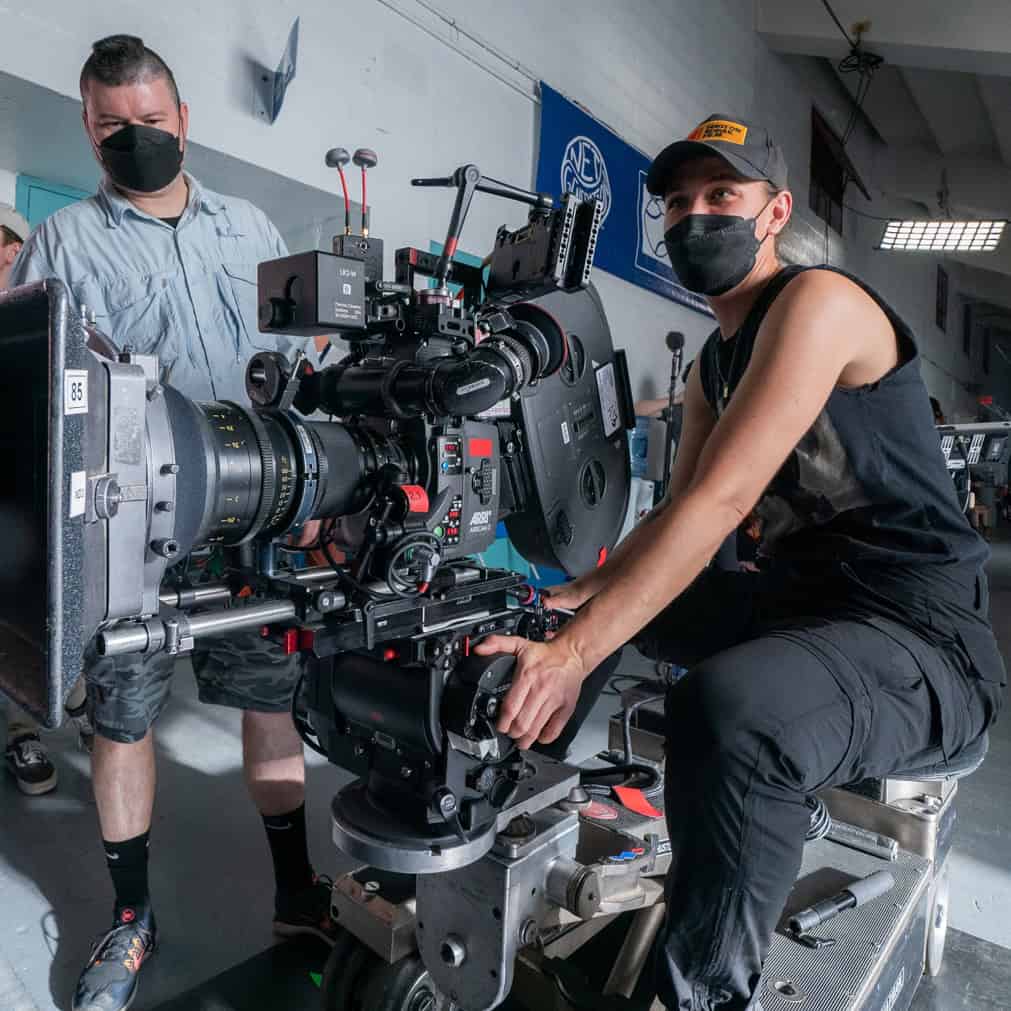
Above Photo: Bianca Butti shooting CHALLENGERS
Photos by Niko Tavernise
TECH ON SET
ARRICAM LT
Zeiss Super Speed Lenses
Angénieux Optimo Spherical 24-290 12x Zoom Lens
Kodak 500T 35mm Film
Photo-Sonics 4B Slow-motion Camera
PHOTO GALLERY
Select Photo for Slideshow
SIGN UP FOR THE FREE
DIGITAL EDITION OF
CAMERA OPERATOR
Click Here
Bianca Butti
Bianca Butti is a cinematographer and camera operator based out of New York. Her work has premiered at numerous festivals around the world including Sundance, SXSW, Slamdance, Byron Bay International Film Festival, New Horizons Film Festival in Poland, and the Scenecs Film Festival in Holland. Bianca recently wrapped production on Lovers, an indie feature starring Angela Trimbur, Amelia Meath, and Benedict Samuel, directed by Taylor McFadden. Another feature she lensed, Measure of Revenge starring Melissa Leo and Bella Thorne, was recently released. She is also known for The Uncanny, which was released in 2023, and An American in Texas starring James Paxton, Tony Cavallero, and Barry Corbin, directed by Anthony Pedone. The feature Hank and Asha, starring Andrew Pastides and directed by James Duff, won her the Director’s Award for Best Cinematography at the Woods Hole Film Festival. In 2019 she shot the critically acclaimed short Untitled Marfa Film, directed by Emily Elizabeth Thomas, which won for Best Cinematography at the Victoria Texas Independent Film Festival. Bianca has also shot numerous docu-series, shorts, and music videos, including Grey Dog, directed by Celia Rowlson-Hall and Petting Zoo, starring Natasha Leone and directed by Durga Chew-Bose. As an A Camera Operator, Bianca has worked exclusively on the last three Luca Guadagnino films, Bones and All starring Timothée Chalamet, Challengers (2024) starring Zendaya, and Queer (2025) starring Daniel Craig, as well as numerous television shows, such as Reboot starring Keean-Michael Key.
Bianca studied cinematography at San Francisco State University, graduating with a BA in Cinema and a minor in painting and drawing. She is interested in the art of creating visually compelling images for motion pictures with the use of light and framing to translate complex human emotions.
